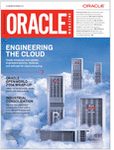Retirement of Oracle AIM & Release of OUM
Posted by Kashif Manzoor on 12th October 2011
 Oracle has announced retirement of Oracle Application Implementation Method (AIM) as of January 31, 2011. Oracle will no longer provide support for AIM Advantage or AIM for Business Flows. Oracle has released Oracle Unified Method (OUM) to achieve the vision of supporting the entire Enterprise IT lifecycle, including support for the successful implementation of every Oracle product.
Oracle has announced retirement of Oracle Application Implementation Method (AIM) as of January 31, 2011. Oracle will no longer provide support for AIM Advantage or AIM for Business Flows. Oracle has released Oracle Unified Method (OUM) to achieve the vision of supporting the entire Enterprise IT lifecycle, including support for the successful implementation of every Oracle product.
“The Oracle® Unified Method (OUM) can help you develop and implement technology-based business solutions with precise development and rapid deployment. You can tailor OUM to support your specific project situation. With its ready-made templates, guidelines, and scalable work breakdown structure, OUM provides the programmatic tools you need to manage the risks associated with your information technology-based projects. OUM supports the complete range of technology projects including deep support for Service Oriented Architecture (SOA), Enterprise Integration, Custom Software, Identity Management (IdM), and Governance, Risk and Compliance (GRC).”
OUM will provide full support, Delivery and Training, for Oracle E-Business Suite R12 engagements. This support represents a major milestone in the evolution of OUM and enables Oracle E-Business Suite practices to begin the transition from the their legacy methods AIM to OUM.
What is OUM?
OUM Features:
- Oracle Support Services Supplemental Guide
- Service-Oriented Architecture (SOA) Tactical Project Delivery View
- Manage technique: Metrics for Agile Projects
- Envision techniques: Accelerating SOA Maturity, Operational Troubleshooting, Service Engineering Process Monitoring, SOA Capacity Planning
- Enhanced / Updated:
- Manage Work Breakdown Structure
- Core Workflow View
- “Planning a Project Using the Oracle Unified Method (OUM) – An Iterative and Incremental Approach” White Paper
- “Managing an OUM Project using Scrum” White Paper
- Template Styles and Format
Download Instructions:
Oracle OPN Diamond, Platinum, and Gold Partners can download from OPN site.
Software Environment Requirements
OUM provides Guidelines, Templates, and Tailored Work Breakdown Structure. You need the following environment installed on your PC to run the OUM method pack.
• Minimum of 1 gigahertz (GHz) processor speed
• 76 megabyte (MB) of disk space
• 520 megabyte (MB) RAM minimum
• Microsoft Windows 7, 2000, XP, NT 4.0
• Microsoft Office 2000 or later
• Microsoft Project 98 or later
• Microsoft Visio 5.0 or later (Optional)
• Adobe Acrobat Reader 6.0 or later
• Microsoft Internet Explorer 6.0 or later, Netscape 7.0 or later, or Mozilla Firefox 2.0.0.16 or later
OUM includes three Focus Areas:
OUM’s Manage Focus Area provides a framework in which all types of projects can be planned, estimated, controlled, and completed in a consistent manner.
OUM’s Envision Focus Area deals with development and maintenance of enterprise level IT strategy, architecture, and governance. Envision also assists in the transition from enterprise-level planning and strategy activities to the identification and initiation of specific projects.
OUM’s Implement Focus Area provides a framework to develop and implement Oracle-based business solutions with precise development and rapid deployment.
The diagram below shows how the Envision, Manage, and Implement focus areas fit together to form OUM: 
The above diagram shows how the Envision, Manage, and Implement focus areas fit together to form OUM.
OUM’s Manage Focus Area, depicted in gray, provides a framework in which all types of projects can be planned, estimated, controlled, and managed in a consistent manner. Its placement in the diagram – encapsulating the yellow Implement Focus Area – and its inclusion at the upper left and top of the red Envision focus area elements of the diagram illustrate how the Manage focus area , to which Program Management shown in blue also belongs, supports delivery of both Implement, and Envision focus area engagements.
OUM’s Envision focus area deals with development and maintenance of enterprise level IT strategy, architecture, and governance. Envision also assists in the transition from enterprise-level planning and strategy activities to the identification and initiation of specific IT projects.
The depiction of the Envision focus area as being both separate from, and surrounding, the Implement focus area, indicates that Envision focus area engagements can be executed independently, but that they may also precede, and run concurrently with, an Implement focus area engagement.
The Implement focus area is that part of OUM that covers the development or implementation of software systems based on Oracle products and technology.
You should use OUM as a guideline for performing information technology projects, but keep in mind that every project is different and that you need to adjust project activities according to each situation. Do not hesitate to add, remove, or rearrange tasks, but be sure to reflect those changes in your estimates and risk management planning.
You can find next note:
http://oraerp.com/blog/oracle-unified-method-oum-implement-core-workflow-part-1/
More details can be found on:
http://www.oracle.com/partners/en/knowledge-zone/applications/oracle-unified-method-359405.html
http://www.youtube.com/watch?v=meDxhJOedWk&feature=player_embedded
Tags: AIM, OUM
Posted in AIM, OUM | No Comments »





